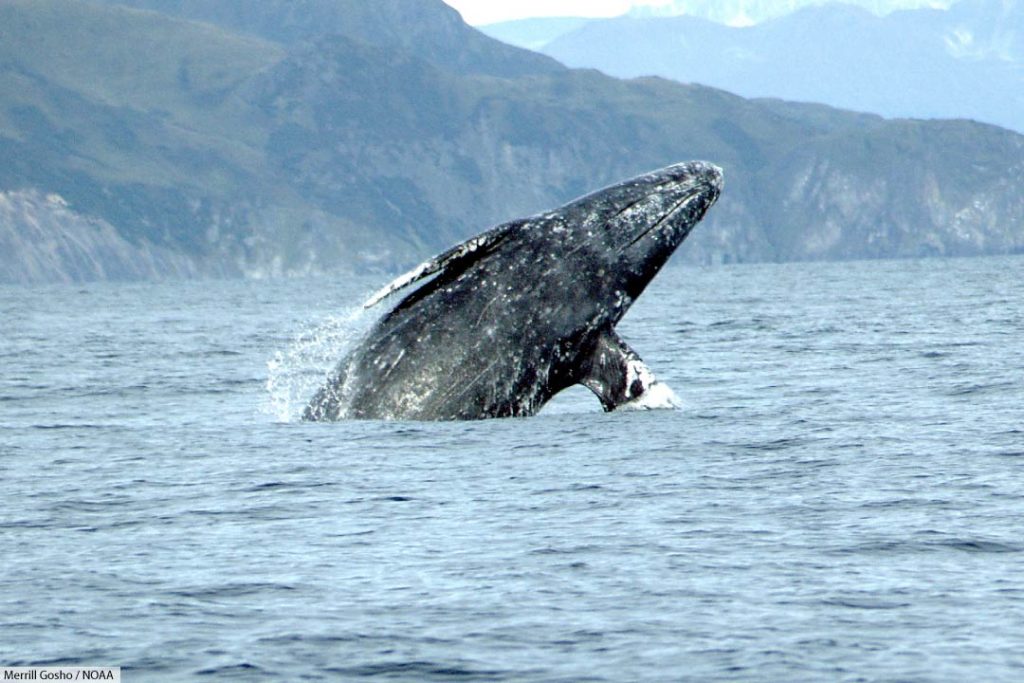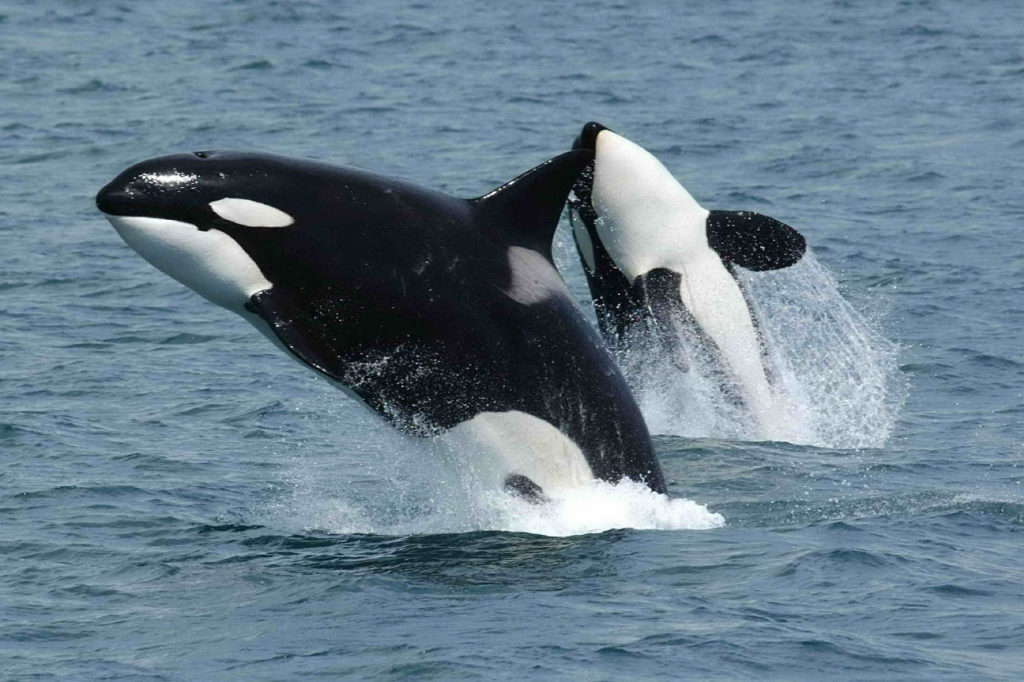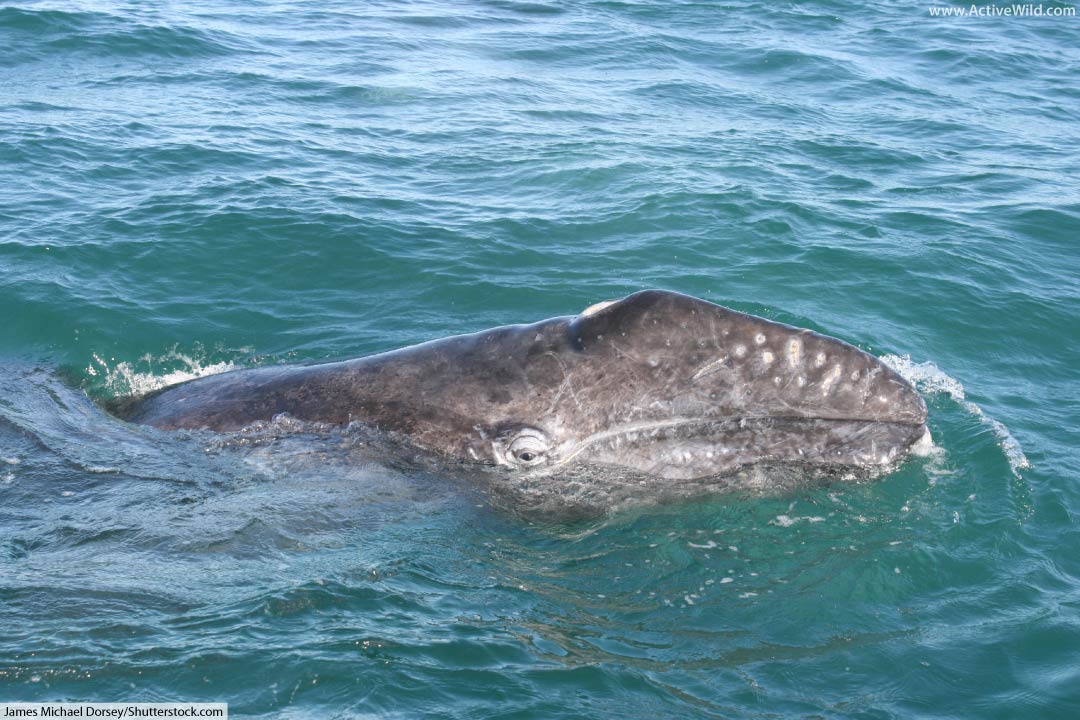Gray whale facts: discover an ocean mammal once nicknamed the ‘devil fish’ by whalers on behalf of its fierce fighting abilities…
Gray Whale Facts At A Glance
- Other Name(s): Grey whale, gray back whale, Pacific gray whale, California gray whale, "devil fish"
- Scientific name: Eschrichtius robustus
- Type of Animal: Mammal, order Artiodactyla, infraorder Cetacea (whales, porpoises & dolphins)
- Animal Family: Eschrichtiidae
- Where Found: North Pacific Ocean
- Length: 40 – 49 ft. (12 – 15 m.)
- Weight: 30 – 40 (metric) tonnes (33 – 44 short tons)
- Conservation Status: Least Concern
Meet The Gray Whale: Introduction

The gray whale (also known as the grey whale) is a medium-sized whale found mainly in the North Pacific Ocean. It is a baleen whale, which (unusually for whales of this type) feeds from the sea bed. The species gets its name from gray patches on its skin, which are scars left by parasites.

The gray whale undertakes a lengthy annual migration between its breeding grounds in the south and feeding grounds in the north. The species holds the record for making the longest migration of any mammal.
Related Pages
- List of all whale species
- Animals: The Ultimate Guide to the Animal Kingdom
- A to Z Animals with Pictures & Facts
- Mammals: The Ultimate Guide
- List of Ocean Animals with Pictures & Facts
Gray Whale Family & Relations
The grey whale is a member of a group of animals known as cetaceans. This group includes all whales, dolphins and porpoises. Cetaceans are members of the infraorder (a group of related animals) Cetacea.
The ancestors of cetaceans were hoofed land mammals. The first cetaceans appeared around 49 million years ago, during the Eocene epoch of the Paleogene period.
Hippos are the closest living land-based relatives of cetaceans.
Cetacea is split into two main groups: the Mysticeti (baleen whales) and the Odontoceti (toothed whales).
Baleen whales are filter feeders. Lacking teeth, they feed by separating food from seawater using comb-like structures called baleen plates located in their mouths.
The gray whale is the only living member of the genus Eschrichtius, which in turn is the only genus in the family Eschrichtiidae. Following recent DNA research, however, some zoologists now place the gray whale within the rorqual whale family, Balaenopteridae.
You can find out more about whale families on this page: Types of Whales
What Does The Gray Whale Look Like?
See a close encounter with a gray whale (and calf) in the video below...
Reaching a maximum length of around 49 ft. (15 m), and a maximum weight of around 44 short tons (40 tonnes), the gray whale is among the biggest whales. It is a similar size to the humpback whale.
The grey whale lacks a dorsal fin. Behind the small hump on its back are 7 to 15 knuckle-like bumps that decrease in size towards the tail.
The whale’s fins are small and paddle-shaped. Its tail has pointed tips and is deeply notched in the middle.
The skin of the grey whale ranges in color from light gray to dark slate-gray. The grey-white patches from which the species gets its name are scars left by skin parasites.

Parasites such as barnacles and whale lice give the grey whale’s skin a rough and mottled appearance.
The baleen plates of the gray whale are cream-colored.
Like all baleen whales, the gray whale has two blowholes. The spray produced by its short ‘blow’ has a distinctive bush, or heart shape.
Female gray whales are usually slightly larger than males, but otherwise there is little difference between the sexes.
Where Is The Gray Whale Found? Distribution & Range
Eastern Pacific Population
The main gray whale breeding population inhabits the eastern North Pacific Ocean along the west coast of North America.
Each year the eastern Pacific population migrates between Baja California in the south and the Bering and Chukchi Seas in the north.
The species spends winter in the southern part of its range, migrating north to its feeding grounds in the spring.

Western Pacific Population
A breeding population that once existed in the western North Pacific is today either extinct or much reduced.
This population migrated between the Sea of Okhotsk (part of the Pacific Ocean between Russia and Japan) and South Korea. The grey whale was last seen in Korean waters in 1977.
Longest Migration
The gray whale is still seen in the Sea of Okhotsk off the Russian island of Sakhalin. Satellite tracking has revealed that at least some of these ‘western’ whales are actually members of the eastern Pacific breeding population that migrate all the way across the Pacific.
Between 2011 and 2012 a gray whale was tracked by satellite making a round trip of 14,000 miles (22,500km) between the east coast of Russia and the coast of Mexico. This is longest known migration of any mammal.
Other Grey Whale Sightings
The gray whale was once also found in the North Atlantic Ocean. It became extinct in this region in the early 18th century.
A handful of gray whale sightings have been made in locations outside of the species’ usual range, including the Mediterranean Sea and the coastal waters of El Salvador in Central America and Namibia in southern Africa.
The Namibia sighting, which occurred in 2013, is the first time the gray whale has ever been recorded in the Southern Hemisphere.
Gray Whale Habitat
Due to its unique bottom-feeding habits, the gray whale is typically found in shallow waters, usually near the coast. Both its feeding and calving grounds tend to have sandy or muddy bottoms.
Gray Whale Behavior
Spyhopping
The gray whale, like many other whales, is known to periodically look out of the water using a method known as ‘spyhopping’.
Spyhopping involves the whale rising vertically out of the water so that its eyes are above the surface. While spyhopping the rostrum (snout) may be exposed for several minutes at a time.
This behavior may be a means of detecting predators or other whales. Or perhaps the whale is just being inquisitive!
Breaching
The gray whale will also occasionally ‘breach’. Breaching is when a whale propels itself out of the water and splashes back down, often twisting onto its side or back. Reasons for breaching may include communication, parasite removal, or play.
Communication
There is some evidence that the gray whale uses a variety of short pulses and moans to communicate, and that it may even use basic echolocation.
Gray Whale Life-Cycle
Mating takes place during the southbound migration between late November and early December.
The gestation period is from 13 to 14 months. Most calves are born during a 6-week period around January.
The calving grounds often have eelgrass beds and may be located close to mangrove swamps.
The female gives birth to a single calf measuring about 4 m (13 ft.) and weighing 400 to 500 kg (880 to 1,100 lb.). The mother suckles her calf for around 7 months.
Adult females usually give birth every two years, but annual births are known.
What Do Gray Whales Eat?

The gray whale is a filter feeder, and unusually for a whale, mainly a bottom feeder. Its diet consists of small sea animals such as amphipods and isopods (small crustaceans), tube worms, cephalopods, the larvae of various animals, small fish and fish eggs.
The grey whale feeds by turning on its side near the sea floor and filling its mouth with sediment. The sediment is then pushed through the animal’s baleen plates, which act like a sieve. The whale then scrapes off the trapped food with its tongue and swallows it.
The gray whale mainly feeds during the summer, replenishing its fat reserves. During the breeding season, the whale goes without feeding and relies on its stored fat.
These reserves are especially important for pregnant and lactating (milk-producing) females, as scarcity of food has been found to lengthen the interval between births.
Grey Whale Predators

The gray whale’s only predator (other than humans) is the killer whale (Orcinus orca). Killer whales usually target gray whale calves. Hunting in pods, they separate the calves from their mothers.
The gray whale will often attempt to evade the predators by swimming into shallow water or kelp beds.
Gray whale mothers are known to be fiercely protective of their calves. This behavior, and the species’ valiant struggles when harpooned by whalers, has eared the species the nickname ‘devil fish’. (Although, of course, the gray whale is a mammal, not a fish!)
Is The Gray Whale Endangered?
The grey whale's IUCN conservation status is ‘Least Concern’.
The estimated size of the eastern North Pacific population is a robust 25,000 to 30,000 individuals.
The gray whale has been protected from commercial hunting since 1949. Other potential threats that have been identified include entanglement in fishing gear, toxic spills and ship strikes.


